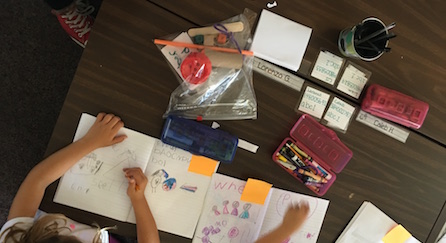






Objects do not move on their own.
Design a solution to a problem using structures that cause movement by pulling or pushing the object.
Soccer equipment cannot move to the field on its own.
Click here for NGSS, CCSS-ELA, and California ELD standards.
How can equipment be moved to the field in one trip?
In Lesson 1: Exploration Box, free explorations using the exploration box were made with pushes and pulls. Investigations included observing the effects that different pushes and pulls have on motionless objects. (CCC) At the conclusion of Lesson 1: Exploration Box, soccer materials were displayed in the classroom or on K.1.R2: Soccer Equipment. Students generated questions about what they need to know to move the materials to the field.
This challenge represents an engineering problem that will lead to planning an investigation to move many objects to the soccer field in one trip. (SEP) Students start with their list of questions about what they need to know to help the soccer coach move the objects to the field. (DCI) One of their questions might be what materials do we have to move them. They are then presented with a set of material in parents’ cars. The criteria for a successful plan includes making one trip to the field and moving by one person. Plans are discussed and partners develop a model of their solution on a poster to share with the class. (SEP) Class discussions focus on how different designs are more effective solutions. (CCC)
The concepts of cause and effect related to pushes and pulls contributes to the understanding of the anchoring phenomenon.
During Lesson 3: Cruising Discs, students explore how to score by changing the strength of pushes and pulls resulting in objects going different distances. (DCI)
Throughout the lesson, a flag ( ) denotes formative assessment opportunities where you may change instruction in response to students’ level of understanding and making sense of phenomena.
) denotes formative assessment opportunities where you may change instruction in response to students’ level of understanding and making sense of phenomena.
| 10 minutes | Engage |
| 10 minutes | Explore |
| 5 minutes | Explain |
| 5 minutes | Elaborate/Evaluate |
Identify the problem of needing a structure to move soccer equipment to the field.
Criteria 1: Equipment must be moved in one trip.
Criteria 2: One person must move all the materials.
Constraints: Use materials in the trunk of the parent’s car.
My partner says _____.Listen to several students share ideas from their partners.
Some students might suggest driving the car onto the field. Tell them this could not be done as there were buildings in the way, and we can’t drive on the grass. Listen to sufficient ideas to help all students realize there is more than one way to move the materials to the field.
Use patterns of movement to design a solution for transporting soccer equipment to the soccer field.

Communicate a solution to the problem of moving equipment to the field identifying the structure to push or pull.



Compare pictures (solutions) to determine the easiest structure to push or pull the equipment to the field.
 Ask students to review the list of different solutions they planned to move the equipment to the soccer field. Ask partners to pick the solution that they think will work the best, place a small sticky note on the plan, and explain why they think it will push or pull the equipment. Compare the numbers of sticky notes by each plan,. Ask students to order the plans from the most selected to the least selected. Lead a discussion that includes the reasons for the selections.
Ask students to review the list of different solutions they planned to move the equipment to the soccer field. Ask partners to pick the solution that they think will work the best, place a small sticky note on the plan, and explain why they think it will push or pull the equipment. Compare the numbers of sticky notes by each plan,. Ask students to order the plans from the most selected to the least selected. Lead a discussion that includes the reasons for the selections.Listen for the use of push and pull as well as logical cause and effect statements. If students do not use the academic language in the descriptions, continue the choice centers with the cards started in Lesson 1: Exploration Box.
It would be appropriate to have students interact with text to extend their understanding of pulls. These selections can be read aloud at any time after this lesson because students have experienced pushes and pulls. Suggested books include:
Fiction:
Nonfiction:
Brett, J. (2015). The Turnip. New York: Putnam Juvenile.
Casas, D. D., & Gentry, M. (2010). The Gigantic Sweet Potato. Gretna, LA: Pelican Publishing Company.
Davis, A., & Petričić, D. (2018). The Enormous Potato. Winnipeg, MB: National Network for Equitable Library Service.
Hester, D. L., & Urbanovic, J. (2015). Grandma Lena’s Big Ol’ Turnip. New York, NY: Albert Whitman Prairie Books.
Llewellyn, C., & Abel, S. (2005). And Everyone Shouted, “Pull!”: A first look at forces and motion. Minneapolis, MN: Picture Window Books.
Peck, J., & Root, B. (1998). The Giant Carrot. New York: Dial Books for Young Readers.
Stihler, C. B., & Trammell, J. (2003). The Giant Cabbage: An Alaska folktale. Seattle, WA: Sasquatch Books.
Tolstoy, A. N., & Sharkey, N. (2019). The Gigantic Turnip. Cambridge, MA: Barefoot Books.